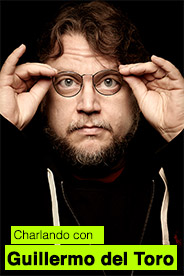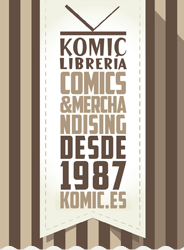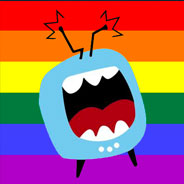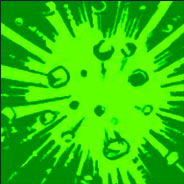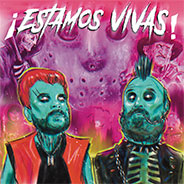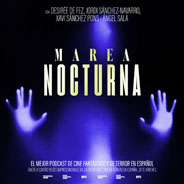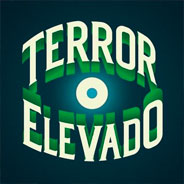You are in front of one of those opportunities that only occurs once in a lifetime. Thanks to the great job and excelent dedication of Enrique Dueñas from PoderFriki.com, here you have an interview that John Howe (www.john-howe.com) granted him to publish at first in this blog. A really great interview, full of wisdom, creativity and above all worship to the creator of this unique art fantasy illustrations. John Howe is, along with Alan Lee, the most relevant illustrator of the Middle-earth, creating images directly from the mind of J.R.R. Tolkien. Take a look now at what he have to say at this site, Uruloki… that is the name of one of the creatures from the mythology of Middle-earth that has in Glaurung his greatest champion!
Something easy for the beginning. We all know you are an expert in medieval history. Your attention to detail when drawing swords, armors and even castles is simply astounding. They are magical, yet realistic. In your opinion, how important is the historical research when painting fantasy worlds?
Essential! Fantasy is convincing when it is "real", albeit in a notoriously subjective and self-contained way. (Once the parameters of a universe have been established, or sensed, any illustration needs to conform to them. If the parameters are supernatural, then that’s of course logical enough, but some sort of inner logic still needs to apply. Fantasy and surrealism are two completely different creatures.)
Of course, when I say research, I don’t mean exhaustive cataloguing, establishment of genii and species; I certainly mean nothing remotely scientific! Much more a certain familiarity, a layman’s working knowledge of things, and this stretches from the hinges on a lobster’s claws to the mortise and tenon work on medieval rafters, from Roman glassware to gothic couters and much more. My mind would be more like Fuschia’s attic in Gormenghast than the stacks in the Library of Congress (at least as far as the dust is concerned).
Being an "expert" is hardly the goal, but being interested certainly is.
The whole idea is that when I wish to draw a window (just an example, and not an exciting one, but you can insert the word of your choice), I wish to be able to be freely inspired by every window, from Celtic to Art Deco, from any age or culture, and not be limited by my unfamiliarity with the extraordinary richness of design through history. There’s a concept I call "design by default", where inspiration is hobbled and blinkered by simple lack of knowledge – and even worse, by lack of curiosity – and that with often impoverished and incongruous results. (I’ve seen fantasy "medieval" castles depicted with windows from pretty much the bungalow next door, from want of familiarity with the extraordinary variety of window shapes and designs that humankind has created. This doesn’t mean I flip through a mental catalogue and copy-paste whatever springs to mind, but it does mean that I can draw on more than just my imagination, and reach towards the ideas of hundreds, if not thousands of generations of creators.
History is always so much richer and more imaginative than fantasy.
I don’t know how many times I’ve been stopped in my tracks by the beauty of some object in a museum or a catalogue, so much more beautiful than anything I could have spontaneously imagined. Rather than carefully setting that object aside to be inserted in a painting at some future date, I try to recall what it was that made me stop in my tracks, and translate onto paper that sentiment when the opportunity arises.
I’m also very sensitive to the blending of functionality and decoration, which is always so crystal clear in any historical object that has been fashioned by and held in human hands. Fantasy is often all about the latter, and often, the former suffers for it.
I do love history; just don’t ask me to recite any dates.
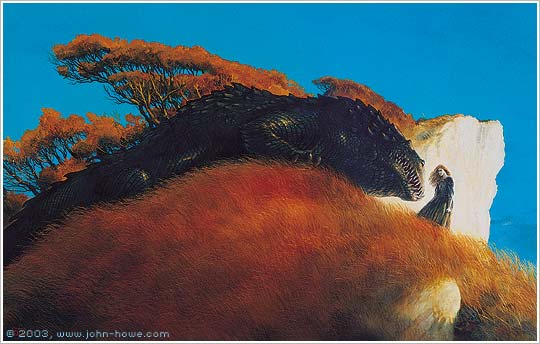
Nienor and Glaurung, 1995
Something that have always impressed me is your use of hard contrast of colors and antagonist elements: fire against ice, gold against blue, light against darkness… it is like seeing a clash of two different worlds. We can see that in pictures like "Dark Heart", "Flight to the ford", "Gandalf falls with the Balrog", "Knight & dragon" or "The fall of Gondolin". Even the ones that did not depict violence, like "Elves & dragons" or "Snow dragon" play with that struggle. I really want to know more about the creative process of some of these pictures.
I am making a lot of confessions in this interview, it seems. I really don’t think about composition, at least not rationally. It’s all smoke and mirrors anyway, in a way. The representation of what you cannot have for real, but only by a form of trickery, is what interests me most. A painting can have two physical dimensions, but the image itself is all about depicting depth and movement (i.e. time), the two things that can only be an illusion on a flat surface.
Contrast is of course a terribly useful tool, but I’d say that it’s all about establishing borders – those places where one thing ceases and another begins, whether it’s light and dark, water and stone, cloud and sky… would you let me include here a few lines from a text I had on my web site some time back? It might be a little long, but I hope you can include it.
I like edges. I like where one thing stops and another starts. I cherish those points of contact, abrupt or indistinct as they may be, whether between atoms or idioms, between states of mind or states of matter.
I like…
… the sea’s edge. Water, rock, sand and pebble, that place between the tides where it’s all noise and rolling and rushing and retreating and returning. A few yards of turmoil or gentle rising falling. It’s hypnotic, especially for a land creature like me who likes something solid under his feet – more the limpet than the albatross, I’m afraid. I pick up shells there, often the broken ones, where the intimate spiraled center is naked, Fibonacci of calcium carbonate, fractal and fragile, inviting helix around which I wrap my thoughts, like two hands, fingers intertwined.
… the edges of cultures, where they meet other cultures and intermingle, imitate, initiate, borrow and exchange. Where one flows into another, like a river into the sea. Where they create a vast delta of channels and waterways, complex, intertwining, everchanging. So many of the most beautiful things ever made have their origins in those places, from Axum to Zanzibar, La Tène to Oxiana, from Moorish architecture to Art Nouveau. All have somehow a harmony that is troubling and fragile, not meant to last, but ageless because of that.
… the edges of story, where go those things too restless to fit between the lines. Devout medieval copists allowed the marvelous to gyre and gimble in the margins of their sacred texts. In the same manner, the gargoyle leers from cathedral parapets. Always leaning over the edge, as pious and profane rub shoulders, exchanging grimaces and trading jokes.
… the word itself. It has a geometry of economy. A compilation of consonants; no lingering vowels or susurrating syllables. Etymologically, it goes way back, to those convenient and amenable Indo-Europeans, on whom we bestow so many things that we cannot see the edge of, so far back is it in time. "Edge" has an edge to it.
I read that you are a great admirer of the Pre-Raphaelite brotherhood and the arts & crafts movement. What do you find more interesting about those paintings? Do you have some personal favorites?
Too many to count! As well as the Pre-Raphaelites, the Symbolists and Decadents, the turn-of the century illustrators of the Golden Age and the quirkest Victorians have my grand admiration as well. Shall I reel off a list of names? In no particular order: Byam Shaw, John Duncan, Askeli Gallen-Kallela, John Bauer, Evelyn de Morgan, William Degouve de Nuncques, Jean Delville, Ferdinand Khnopff, Solomon J. Solomon, Carlos Schwabe, Frantisek Kupka, Fernand Keller, Thomas Cole, J. W. Waterhouse, Hermann Heindrich, Viktor Vasnetzov, George Frederic Watts, Franz Von Stuck, Simeon Solomon, Gustave Doré, Amos Nattini, Henri-Jean Guillaume Martin, Gustav Adolf Mossa, Richard Dadd, W. Russell Flint, Elihu Vedder, Willy Pogány, Ferdynand Ruszczyc, Charles de Sousy Ricketts, Odilon Redon, Robert Hughes, Lucien Levy-Dhurmer, Giovanni Segantini, Francis Danby, John Martin, Herbert Draper, Sidney Sime and most certainly a hundred (or several hundred) more.
I also am struck by the suspension of time, that sometimes works of art, humble or magisterial, can reach out and touch us directly, across centuries. It might be anything, but that sudden striking of a chord is a magic moment. I do my best to make the humble pilgrimages I can, and go to museums in order to see originals I know by heart from catalogues and books, because that coinciding of circumstance, actually standing in front of a painting or a statue, is the coming together of two unique things (there’s only one of each, you and the painting) no matter how modest. It’s one of the reasons I feel digital art takes away an important opportunity. If you knew that 100 museums had exactly the same print from a unique digital file, would you bother to go and see? Every time I have seen an original piece of art face to face, so to speak, is a moment treasured and a milestone on a journey of sorts.
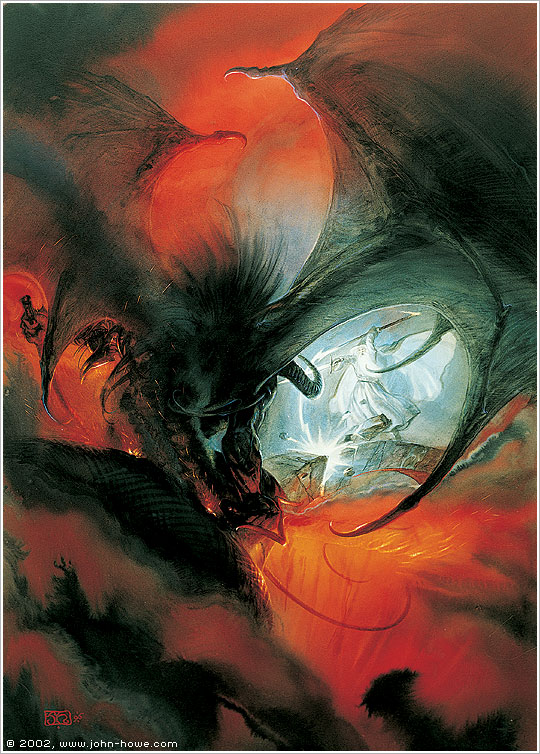
Gandalf and the Balrog II (49.4 x 68.8 cm), 1996
Most of your illustrations depict the classic conflict of man versus beast. In ancient mythology, the hero is a champion of the incipient civilization while the monster is a symbol of chaos. But in your paintings, the creatures are incredibly beautiful and fascinating. They look powerful, maybe fearful but no nightmarish at all. They came from the natural world, not hell. And the heroes, in spite of looking stoic, are never so visually attractive and most of the time they even don’t have faces. Is this deliberate? You identify yourself more with the monster than with the hero? Another feature of all that paintings is that the image seems to be frozen during the highlight of the combat so we never see which one win. Again, is this deliberate? Have all that conflicts a resolution at all or there are some kind of infinite battle?
I think you’ve answered that beautifully; next question, please! Myth is the enveloping of governing principles and grand designs in the particular and the anecdote, which serve as vehicles, so that we can more easily understand them. Fantasy often displays the colourful trapping of myth, but never goes beyond anecdote, and easily strays into adventures of a purely human dimension. (Keeping in mind of course, that wherever myth is concerned everything means it’s opposite and the contrary, but honestly I find Russell Hoban’s The Mouse and his Child far more mythical than all R. E. Howard’s Conans put together.)
But, to try to answer your question, I’m rarely content with simpler notions of good and evil, the handy dichotomy to which so much fantasy is reduced. I dislike the superficiality that dictates a the approach to much fantasy art – muscles and chain mail bikinis do not real fantasy make, and although they proved attractive posters for teenagers, they don’t go beyond clever surface effects. I’d rather see something much less deftly executed but that contains some depth.
I suppose as well, I’m simply not attracted to artwork that is destined for primarily for posters, where representation takes the place of narration, where the character are basically posed, the action put on pause, and almost a sort of eye contact is established between the characters and the viewer; I’ve always preferred imagery that does not require the acknowledgement of the spectator as an active participant. (It’s difficult to explain, and I’m not doing very well here, but the difference seems very clear to me, you know those images of heroes smiting foul eldritch creatures where everyone – hero and monster – seems intent on holding the pose, so we get their best sides.)
And you’re right. There is no resolution. Or perhaps there is, but the journey is always more interesting than arriving, especially as we know the final destination.
Apart from Tolkien, I want to know what modern fantasy fiction had more impact on you. Maybe Lord Dunsany stories? Edgar Rice Burroughs? Fritz Leiber? Pulp masters like Lovecraft, Robert E. Howard or Clark Ashton Smith? Did you like old fantasy movies like the Ray Harryhausen adventure tales (Jason and the Argonauts, Sinbad…)?
I have to confess somewhat shamefacedly while my peers were likely reading Homer, I was reading Tarzan… public school education in small towns in western Canada was basic at best. (I dare hope it has improved now, but I wouldn’t place a bet on it.) I used to scour used book shops for paperback covers by artists I admired, and most likely ended up reading the paperbacks themselves, a lot of mediocre fantasy and science fiction, most likely. (I doubt I would have appreciated Dunsany, of whom I of course knew, but only recently rediscovered through Sidney Sime’s magnificent illustrations.
I still enjoy reading Howard, but can hardly bear the writing style. With Lovecraft, I fare rather better; my all-time high fantasy favourite is The Dream-Quest of Unknown Kadath, of course, which I would eagerly take any opportunity to illustrate. (More than Kadath, though, it’s for Robert Holdstock’s Mythago Wood I would love to create imagery. His death recently was a shock to us all.)
I don’t have a lot of patience with old fantasy films, I never saw them when I was younger so cannot watch them with nostalgia. I do recognize the pioneering spirit, though, and did have the honour to meet Harryhausen a few years ago.
On the other hand, one should never underestimate modern fiction. Look what Tolkien has done for Elves and Dwarves, not only single-handedly lifting the former out of their diminutive Victorian fairy ring revels, but rehabilitating and possibly even changing the orthography of the latter. We have often quite nebulous notions of the denizens that inhabit popular culture; it would be fascinating to ask what those words evoke to people from different centuries.
In a sense, myth is about connections. If we need them, then the stories necessary to make those connections are there should we care to look. This said, a simple dusk or dawn can be mythological if you look at it the right way. I can understand, though, that in the face of modern life, these things be considered trivial compared to more material pursuits.
I heard recently your conference about "the man who draw". You feel genuinely worried that most of men and women only let his left hemisphere to take decisions. You really think that "drawing" is so uncommon between grown ups? I find very interesting the conflict between our analytic side and the realm of imagination, and the whole idea of people that imprisoned themselves into that system. In your opinion, how much can a man learn after taking a pencil?
I’m convinced much can be learnt, and that by anyone. As a literate society, communication passes by learning to write, an exercise so opposed to drawing that it’s a small wonder so many adults yearn to resume with drawing but cannot. I see any artistic pursuit as a form of equilibrium. It’s also another means of expression, like learning another language. More than wishing every adult would be carting a sketchbook about making pretty drawings, I would be reassured if they were simply looking at things. John Ruskin has similar ambitions with his ideas of drawing classes for factory workers. The act of transferring what you see or feel into another medium is not only a beneficial act in itself – drawing can almost be a form of mediation – it is also a supplementary point of contact with other individuals.
To answer your question, perhaps most adults cannot learn to draw, but I do regret that those who do wish to re-learn the freedom they possessed as children should hesitate to do so simply because they do not know how to go about it.
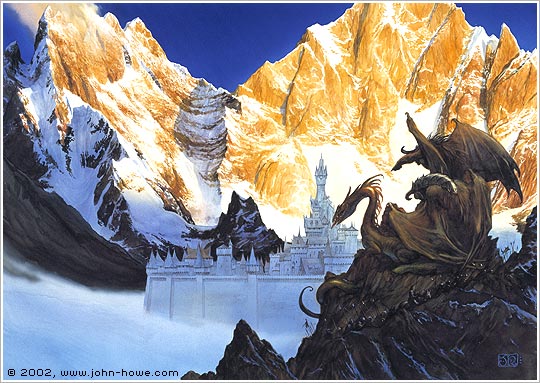
Morgoth’s Forces before Gondolin (46.0 x 64.3 cm), 1990
My favorite John Howe painting of all time is "Morgoth’s Forces before Gondolin". I spent many years of my life fascinated with that horrifying demons looking with envious eyes at a marvelous fairy tale city. But both the Morgoth forces and Gondolin are a minor part of the illustration. The fact is that most of the picture is that colossal depiction of the Swiss Alps that makes the entire conflict look little. Why you choose that composition for the image? Apart from it pictorial advantages, are you dealing with some underlying themes? Another thing that always surprised me about this picture is how calm and peaceful everything looks. There is going to be a terrible, bloody war. The entire city is going to be destroyed and its inhabitants will die. But the paintings have a sense of quietness. Why do you choose that approach?
I believe there are at very least two threads, if you will, to any tapestry; in a sense, the warp and the weft of any image-weaving. The warp is the underpinning of the image, the explicit narrative, which goes well beyond the edges of the image itself, implies events leading up to the moment depicted, and hints at what comes after. The weft is the inherent coherence of the image itself: how the colours play against each other, the composition, the physical dynamics of the image itself. These are woven so inextricably together that separating them out gives you those horrid composition analyses full of circles and triangles and arrows and a lot of nonsense about golden means and pyramidal compositions (not that these aren’t there, of course they are, but image analysts are often so pedantically illegible you’re better off skipping those parts of the book) coupled with observations that have little grounding in the actual image itself. Moreover, the two are often impossible to separate (dissection is usually fatal to any specimen).
Actually, you might consider an example: I did an image for Beowulf a few years ago, of the dragon moving across the landscape, leaving a trail of fire and scorched earth in his wake. Everything in the image is moving from left to right: the wind, rain, incoming waves, the contours of the foreground, the succeeding planes of the image, the smoke from the embers and the dragon’s jaws, as well as the dragon himself. These are all the explicit temporal elements underpinning the story: the dragon has emerged from his grotto (somewhere stage left) and will he razing villages (way off stage right). The only element facing left is the dragon’s head, which leads the eye back up into the image and maintains the visual and compositional unity; the narration may spill over both sides of the frame, but the composition doesn’t. (Flip the dragon’s head horizontally in Photoshop and you’ll see what I mean; the image doesn’t work at all any more.)
Of course, I don’t for a nanosecond pretend I thought all that out before painting the picture! Of course I didn’t, and only really tried to articulate what I thought functioned and why well after, for a book on fantasy painting. As well, certain landscapes have come to irrevocably associate themselves in my mind with certain stories. I’m not planning a guidebook to fantasy landscapes in the real world here, but I find it’s become an important part of how I see things. There’s a lot of New Zealand in my Tolkien work, but I couldn’t put a North American landscape in there to save my hide, it just would not feel right. You might also be surprised how much Swiss landscape, even places just a few miles from our home, has found its way into my work. If you were to visit Devon, you’d see Alan Lee paintings everywhere you look. (I imagine science fiction illustrators can’t really rely on their surroundings, but fantasy illustrators certainly can.)
You are right that the landscape is often a lead player in a painting, and often in a role that appears at odds with the principal scene. It’s a game, in a way, but symbology in landscape, if it is carefully utilized, can be a most powerful element. It can not only advantageously situate and frame and event, but can be a geological transposition of that same event, a sort of magnification of the same.
Concerning action itself, especially violent action, I truly believe that the potentiality of that action can be contained in the split second preceding the action itself. (You know, that slight drawing in of breath, drawing back of limb and tensing of muscle that contains the imminent movement.) I believe that moment is more powerful than a stop-action image, (something that comics prefer, generally with lots of dramatic foreshortening; I’ve always found that Burne Hogarth’s work contains no action whatsoever) as it contains the ingredients needed for the viewers to imagine that action, rather than handing it to them on a plate.
8. Now, for the finish, some divagation. The legends from the past are not only exciting tales, but a symbolic vision of our reality, containing true knowledge and advice. Most of people don’t seem to respect that kind of wisdom. They even don’t teach that kind of things in schools anymore. I really want to know your opinion about the importance of ancient myth in the modern society.
I’d be tempted to say we should not overlook stories that have survived millennia, long after they had lost all religious meaning. While we no longer "believe" ancient creation myths in the way those who first told them believed, we can count on Frazier and his successors to help us understand what we no longer truly grasp. Is it "useful" in the strictest sense? I believe so, as it is a dimension of what makes us human, and it is art. To dismiss it as trivial would be an error. To grasp it intellectually is for scholars, but to be stirred by it, to be moved, to feel that there is something without necessarily being able to put one’s finger on it, is the true purpose of myth. Myth is a place, and like most places, the most interesting regions are the marches, the borders, the edges and frontiers, where you’re not quite sure what’s real and what isn’t.
That’s the place to travel: the Edge of Myth. If there is one place that defies description, that cannot be accurately mapped, it is that place. Somewhere in the land of myth-image, beyond the predictable geography of the Euhemerist, deep in the world-before, , where there existed a dialogue we can no longer truly grasp. Mythology comes from a time before the world was a thing. As modern humans, we live in the era of "It", where the workings of the world around us are explained scientifically. We do not need to know too many things; we can look them up in books and encyclopedias if we wish. Knowledge is less what our heads can hold than what books our local library can loan us, or what clever keywords we can type into a search engine.
For thousands of years, humanity lived in a somehow richer age, the time of "Thou" when the world needed to be addressed as one would another living, reasoning creature, moreover an occasionally fickle, unpredictable and implacable one. Life could be hard, life needed to be negotiated. An age of propitiation, of dialogue, of thanks-giving. If fire came forth when stones were struck together, then the fire was contained inside the stone, imprisoned until it was freed. To better explain, to more easily remember, a story was made, a tale of flint and how it swallowed fire, so that the knowledge could be passed along and its importance live on undiminished. (I often think stories grow like that. Like a stone, patiently waiting to become a flint.)Naturally, when these stories no longer explained nature, they were still told, but they were no longer myth, since what they held that was sacred had come to be understood in another way. They became folk tales, fairy tales, old wives’ tales, and joined other dusty books on library shelves. And, while we still told the same stories, we forgot their meaning, and now, if we smile or shrug a little too easily when we read curious legends, it’s just because we read the names but no longer know what they truly mean…
Interview to John Howe by Enrique Dueñas on September 8, 2011.






